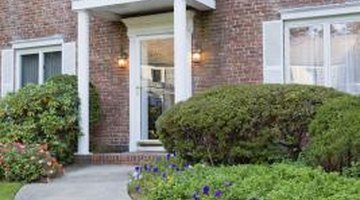How Much Air Space Between Brick Veneer and Sheathing?
Brick veneer is a common building material that looks just like standard brick from the exterior. If you were to slice open a brick veneer wall and peer inside, you would see that the brick is only 1 inch deep. Brick veneer is not structural. The structural part of the wall is underneath the brick veneer. It is often wood. The exterior of the wood wall is called "sheathing."
How Much Space?

Capable masons build a 1-inch space between the brick veneer and the sheathing. The actual depth of the space may vary by a small amount -- it may be 1/2 inch larger than an inch. The space between the veneer and the wall is an important part of the wall and should not be filled.
The Function of The Space
Brick, including brick veneer, may look waterproof, but it isn't. Brick and mortar absorb water during rainstorms and times of high humidity. If brick veneer is in contact with the sheathing beneath the wall, the sheathing is subjected to nearly constant moisture and cannot dry out appropriately. Over time, this causes the sheathing under the veneer to rot or mold.
Flashing and Weep Holes
To provide a surface for rain to run off, flashing is inserted near the bottom in the space between the sheathing and the brick veneer. Flashing is a sheet of metal attached to the sheathing with a sloped bottom that runs to the brick veneer. Rainwater collects on the flashing and rolls down to the brick veneer and away from the sheathing.
Weep Holes
Weep holes are holes between the joints near the bottom of the brick veneer wall. These holes allow the water collected by the flashing to run out of the wall and back outside. Weep holes, along with flashing and the empty space between the veneer and the sheathing, are a critical part of the home's moisture-management system.
Moisture Barrier
To further protect the sheathing from moisture, a moisture barrier is wrapped around the sheathing. The moisture barrier may be made from rain screen, which is a barrier between the sheathing and the veneer with its own air cavity meant to act as an obstacle for rain. Instead of a rain screen, grade D kraft paper may also be used. The moisture barrier prevents water from seeping into the sheathing beneath.
References
Writer Bio
Leslie Rose has been a freelance writer publishing with Demand Studios since 2008. In addition to her work as a writer, she is an accomplished painter and experienced art teacher. She has a Bachelor of Arts degree in art with a minor in English.
Photo Credits
- Jupiterimages/Creatas/Getty Images
More Articles



